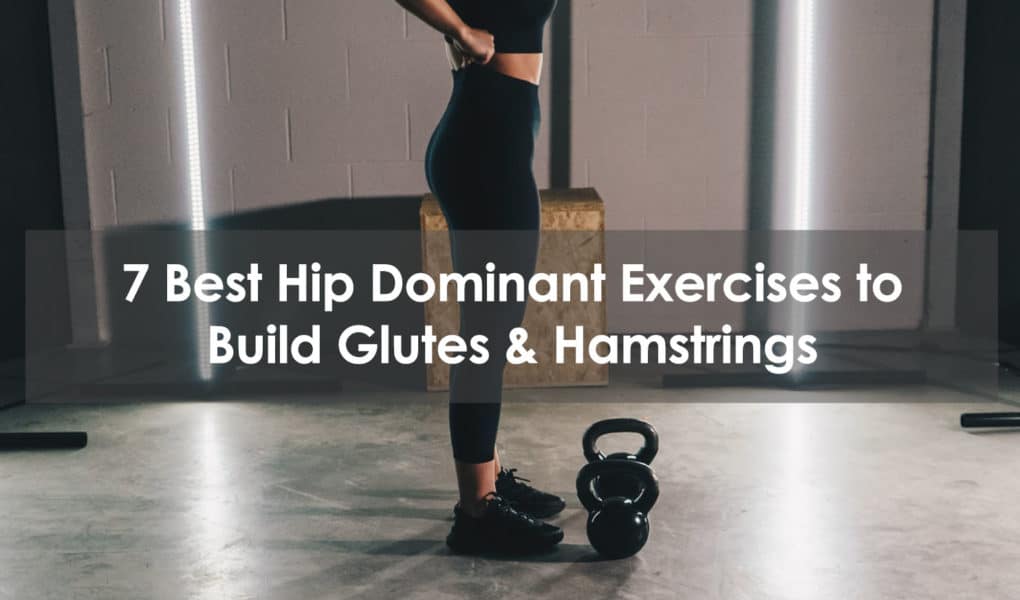Your glutes and hamstrings are among the most used and biggest muscles in the body. Every time you sit, stand, or walk, they come into action. For many people, though, the hip flexors, glutes, and hamstrings are chronically undertrained. That sets them up for injury and prevents them from achieving their lower body strength and development potential. Hip dominant exercises, which lengthen the hip, are the key to building the glutes and hamstrings.
In this article, I lay out the seven best hip dominant exercises to target the glutes and hamstrings.
1. Conventional Deadlift
Muscles Worked
Glute maximus, erector spinae, and hamstring muscles
How to Do It
- Stand in front of a loaded barbell with your feet shoulder-width apart, with the toes forward so that your midfoot is under the bar.
- Hinge at the hips and push your hips back with a slight bend in your knees as you reach down to grab the bar with a slightly wider than shoulder-width overhand grip.
- From this starting position, lift the chest, take a deep breath in, and then stand up straight.
- Now hinge your hips, drive your butt back, slightly bend your knees and return the bar to the floor.
- Do 3 sets of 15 reps.
Training Tips
One of the biggest training mistakes is not to pause between reps. Between each rep of the conventional deadlift, there should be a ‘dead’ stop on the ground. Give yourself a moment to reset, create tension and take a deep breath before the next rep.
2. Good Morning
Muscles Worked
Glute maximus, hamstring, and spinal erector muscles
How to Do It
1. Place a barbell behind your head across your shoulders and upper trapezius, supporting it in your hands with an overhand grip. Keep your feet hip-width apart.
2. Hinge at the hips and drive the hips back as you bring the torso down towards the floor in a bowing motion. Maintain a neutral spine position.
3. Drive back to the start position, pulling through the hamstring and erector spinae muscles.
4. Do 3 sets of 12 reps.
Training Tips
Use a relatively light weight (I suggest starting with just the bar). Using a heavy weight that forces back rounding is one of the biggest training mistakes in this exercise. Do not round your lower back and concentrate on pulling up through the hamstrings more than the back. This exercise is essentially the reverse of Romanian deadlift, with the bar across your back rather than held at arm’s length.
3. Banded Clamshells
Muscles Worked
Glute medius, hip extensor muscles
How to Do It
1. Place a loop resistance mini band around your mid-thighs and lie on the floor on your left side with your knees bent and legs stack one on top of the other.
2. Keeping your top foot down, open up your legs by lifting your top knee as wide as you can.
3. Hold the top position for a count of 2 and then lower to the start position.
4. Do 3 sets of 14 reps on each leg.
Training Tips
This is a great exercise to target the gluteus medius at the side of the hip. This is a small muscle so do not use a band that is too thick or you won’t be able to move this muscle through its full range of motion.
4. Stability Ball Prone Hip Extension
Muscles Worked
Hamstrings, spinal erector muscles
How to Do It
Lie face down on a stability ball so that your hips are on the ball and your hands resting palms down on the floor.
2. With your legs out straight, hinge at the hips to bring your legs up higher than the level of your torso.
3. Lower under control until your feet are just off the floor.
Training Tips
Activate your glutes and hamstrings and keep your core tight.
5. Band Hip Extension
Muscles Worked
Glute maximus, hamstrings, and hip extensor muscles
How to Do It
1. Stand with a resistance mini band looped around your ankles and feet hip-width apart. Clasp your hands together in front of your body.
2. Without bending your knee, pull your left leg back as far as you can.
3. Return to the starting position under control.
4. Do 3 sets of 12 reps on each leg.
Training Tips
Maintain an upright torso position; do not lean forward with your upper body as your leg goes back (you may wish to hold onto an upright for support). You can also do this exercise with an ankle weight.
6. Alternating Forward Lunge
Muscles Worked
Hamstrings, quads, gluteus maximus
How to Do It
1. Stand with your feet together and your hands on your hips.
2. Take a large step forward with your right leg and drop down into a lunge position, with your rear knee just touching the floor.
3. Push back to the start position.
4. Now take a large step forward with your left leg and drop into a lunge position, also bringing the rear knee to the floor.
4. push back to the start position. That is one rep.
5. Do 3 sets of 12 reps.
Training Tips
Maintain an upright torso position throughout, keeping your spine in a neutral state. You may wish to hold hand weights to add resistance.
7. Step Down
Muscles Worked
Hamstrings, glute muscles
How To Do It
1. Stand on top of a step or bench that is 16 to 24 inches from the floor.
2. Lift your left foot off the step, hinge your hips back, and slowly lower the foot to the floor.
3. Without resting your foot on the floor, lightly tap the floor with your toe, then drive up with the leg that’s on top of the box.
4. Repeat with the other leg.
5. Do 3 sets of 12 reps on each leg.
Training Tips
The key to success with this exercise is to make a fast transition between lowering and lifting the foot. You can also perform the step-down exercise with a pair of hand weights for added resistance. The difference between this exercise and the step up is that the reverse action targets the hamstrings as opposed to the quadriceps on the step up.
Conclusion
You now have 7 of the best hip dominant exercises that exist to strengthen your glutes, hamstrings, and hip flexors. I recommend that you experiment with them to find which ones work best for you. Then combine your top 3 into a workout routine that you perform two times per week, giving a gap of 48 hours between each session. Do this consistently for 12 weeks and you will dramatically improve your lower body strength.
Frequently Asked Questions
How do we use the hip extension in our daily activities?
Every time you do something that lengthens the front of your hip, you are performing hip extension. That includes walking, sitting, and running. As a result, hip extension is part of nearly everything that requires bodily movement.
Why is it important to strengthen the hip extensors?
The hip extensors are major movers of the body. If they are weak, you may compromise your normal movement pattern, making you prone to injury. Hip extension exercises will strengthen this area of your body.







